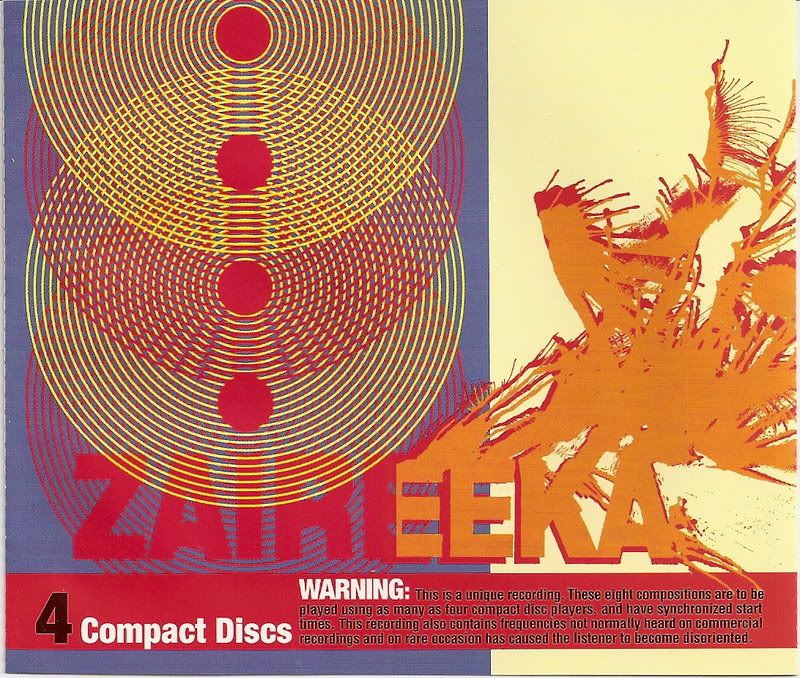 If our previous class session explored an art-object through its negative image (i.e. Cage's 4'33'' as music), then today's class session challenges us to consider an art-object as an intensification of its traditionally-conceived identity. In the liner notes to Zaireeka, Wayne Coyne of the Flaming Lips writes: "I was discovering the possibilities of using separate sound sources to expand on the ideas of composing and listening"; likewise, in creating a single album that needs to be experienced by playing 4 CDs simultaneously, he wanted "to think with an 'expanded' view of what music and songs could be," so as to "hear an exaggerated dimension of sound." As such, if one conceptualizes 4'33'' as music from the perspective of less than music, then one can conceptualize Zaireeka as music from the perspective of more than music. To wit, for your next blog post, I would like you to think through your sculpture as an intensification of a) the object it represents, b) an art-object, or c) the natural environment in which it is found. Posts should be 500 words, contains 1 mutli-media element, and 2 relevant hyperlinks. DUE: Tuesday, December 1 @ 12:30PM.
If our previous class session explored an art-object through its negative image (i.e. Cage's 4'33'' as music), then today's class session challenges us to consider an art-object as an intensification of its traditionally-conceived identity. In the liner notes to Zaireeka, Wayne Coyne of the Flaming Lips writes: "I was discovering the possibilities of using separate sound sources to expand on the ideas of composing and listening"; likewise, in creating a single album that needs to be experienced by playing 4 CDs simultaneously, he wanted "to think with an 'expanded' view of what music and songs could be," so as to "hear an exaggerated dimension of sound." As such, if one conceptualizes 4'33'' as music from the perspective of less than music, then one can conceptualize Zaireeka as music from the perspective of more than music. To wit, for your next blog post, I would like you to think through your sculpture as an intensification of a) the object it represents, b) an art-object, or c) the natural environment in which it is found. Posts should be 500 words, contains 1 mutli-media element, and 2 relevant hyperlinks. DUE: Tuesday, December 1 @ 12:30PM.And for your viewing pleasure, the below video contains some footage of the "Parking Lot Experiments" that was the impetus and/or origin of Zaireeka:
You will also have a second writing assignment over break. As with our pre-writing assignments for previous Writing Projects, you will do some research on the historical and cultural context from which the sculpture derives. Your research will have a two-fold purpose: 1) it may provide you with new ways of envisioning and interpreting particular aesthetic and technical considerations, and 2) it will provide you with material in which you may situate your introduction, conclusion, or possibly both. After you’ve completed your research, return to the sculpture and re-examine it. How have your insights altered your perceptions? You may also want to consider how the medium allows to creator of the sculpture to write about or express certain views that other mediums might not effectively handle, or presents them in a certain manner that allows for a different understanding of the material. DUE: Tuesday, December 1 @ 12:30PM.
Finally, you might be asking yourself: "Okay, I understand these differing conceptual models you want us to view our art-objects through, but why must we participate in these experiments/activities in class?" Again, Coyne provides us with a glimpse of why this is. He claims that we must not just passively "witness an event," but actually "be the event." To this extent, proper understanding of an art-object requires immersion within it to achieve the fullest experience: one must become art. No doubt, to observe, reflect upon, and conduct research regarding your primary text is necessary in an effort to arrive at the most well-round comprehension, but envelopment within the art-object, or affectively entering the piece in a visceral manner, must occur. Therefore, when we return from Thanksgiving break, we will use our final 2 class sessions (not including peer-reviews) to spend some quality time with our sculptures: watching them, touching them, talking to them, etc.
No comments:
Post a Comment